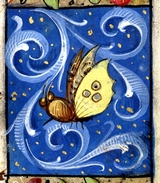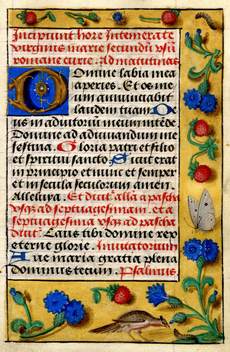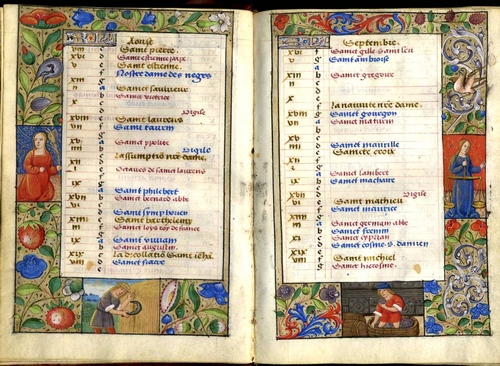The floreal borders


The floral borders, to iconography
and
style, hortus conclusus be traced, or that image inspired by the
applicant in the Middle Ages and the Song of Songs that says "You
are an enclosed garden, my sister, my bride, an enclosed garden, a
fountain sealed." Represented by a secret garden and fantastic,
which provides shelter from evil, in which flowers and fruits grow
allegorical, always associated with the figure of the Virgin Mary
and Heaven.
The rose is the flower
par excellence linked to Maria also called the "rose without
thorns" that is not touched by original sin, because tradition says
that the rose garden of Eden was thornless. The rose has thorns but
with the attribute of martyrdom. The flower is also found in some
episodes of the Holy Family and in the images of the Holy
Sepulchre. Red roses can also represent the blood of Christ and the
white are washed by the tears of the Virgin. Even the iris, the
different colors, is commonly considered a flower of the Virgin
 and sometimes replaces the lily in the scenes of the Annunciation,
in other cases it is associated with his grief over the death of
Jesus.
and sometimes replaces the lily in the scenes of the Annunciation,
in other cases it is associated with his grief over the death of
Jesus.
The viola in popular imagination is a symbol of modesty and humility, for this is also likened to the Virgin but also to Jesus who had the humility to become a man.
The cornflowergrows wild in fields of wheat is associated with the figure of Jesus as the bread of the Eucharist and even the
defeat of the devil because the flower is attributed properties
against snake bites.
with the figure of Jesus as the bread of the Eucharist and even the
defeat of the devil because the flower is attributed properties
against snake bites.
The strawberry is considered food of the blessed and as such recalls the image of Paradise. Is associated with the Annunciation and the Incarnation of Christ, who according to tradition, took place in spring, while the birth of the fruit.
 The lily, the Old
Testament who was associated with fertility and beauty, in medieval
iconography, recalls the story of baby Jesus who gives flowers of
lily of the saints and is connected to chastity and purity. To this
becomes one of the symbols that most often accompanies the figure
of the Virgin, especially in the scenes of the Annunciation.
The lily, the Old
Testament who was associated with fertility and beauty, in medieval
iconography, recalls the story of baby Jesus who gives flowers of
lily of the saints and is connected to chastity and purity. To this
becomes one of the symbols that most often accompanies the figure
of the Virgin, especially in the scenes of the Annunciation.
The pomegranate in the Middle Ages is often depicted holding the Child Jesus and the Resurrection as a symbol of the future in the hands of Maria may indicate chastity.
 We mention briefly the allegorical meaning attributed to the
animals that inhabit the decorations in the books of Hours
We mention briefly the allegorical meaning attributed to the
animals that inhabit the decorations in the books of Hours
The bird, often present in the border, like the butterfly represents the human soul leaves the body at death.
soul leaves the body at death.
The snail, animal closes the shell, in Christian doctrine has become a symbol of virtue and sobriety.

The viola in popular imagination is a symbol of modesty and humility, for this is also likened to the Virgin but also to Jesus who had the humility to become a man.
The cornflowergrows wild in fields of wheat is associated

The strawberry is considered food of the blessed and as such recalls the image of Paradise. Is associated with the Annunciation and the Incarnation of Christ, who according to tradition, took place in spring, while the birth of the fruit.

The pomegranate in the Middle Ages is often depicted holding the Child Jesus and the Resurrection as a symbol of the future in the hands of Maria may indicate chastity.

The bird, often present in the border, like the butterfly represents the human

The snail, animal closes the shell, in Christian doctrine has become a symbol of virtue and sobriety.


